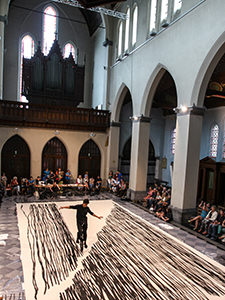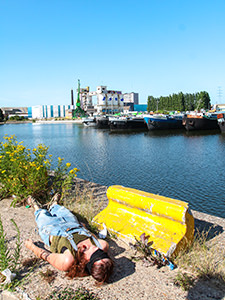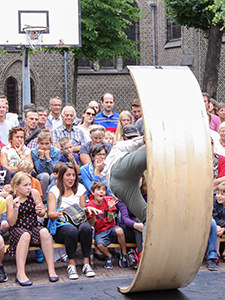It’s a sunny day in Ghent, the capital of East Flanders. People stroll along the canal. Many ride bicycles, as Belgians usually do. Some just lie on the grass soaking in the sunshine.
A young blonde woman is sitting on her picnic blanket and enjoying a glass of red wine. The brand of the wine is not known, but who cares? On a sunny day, the relaxing state of mind is a matter of choice.
But then another woman in business attire passes by, with a bucket. She stops by the picnic blanket, turns the bucket upside down, and pours several liters of tomato puree over the blonde!
Nobody gets mad. It is a performance. One with a lot of spilled milk, smashed cake and crushed watermelon.
Nobody should cry over the spilled milk though. Celine Verkest, the artistic director of the festival that programmed Cie Woest’s show “Lucky Shots” in one of the city parks, assures me later that all of that scattered food will not be wasted – local pigs will have a feast too.
Welcome to Miramiro Festival!
Being a street performer is not easy. Check out what artists have to handle at Sziget Festival in Budapest!
Entire Ghent becomes a stage
This (more than just a) street theater festival exists since 2000. It was established in the framework of Gentse Feesten (Ghent Festivities), that is probably the largest world festival combining music and street theater.

Every year in the second half of July, the medieval city of Ghent attracts about 2 million visitors, which puts Gentse Feesten among the most popular European festivals, in the company of Fallas in Valencia or Oktoberfest in Munich.
The first festivities were held in 1843, while the modern era of the festival started in 1969 with one stage only. Since the late eighties the growth has been rapid, and today the city bans the traffic in Ghent center, in order to control the flow of the masses more efficiently.
The party mayor takes over the city, and the pedestrians take over the streets. The exhilarating combination of staged and random busking events, the diversity of forms ranging from world to choral music, from circus and street theater to parades and exhibitions, makes Ghent an exciting meeting point.
From food stalls and pop up bars to public urinals, there are long queues of people determined to consume the largest European cultural open-air event.
Nobody can close itself in a fancy bar at Titanic, raise the volume up and pretend not to hear the boat engines dying off
With so many possibilities to buy booze, public drunkenness at this mass event is an unavoidable thing. And while the operators riding the wave of quick profit are plentiful, Miramiro Festival stays one of the most decent additions to the Ghent wildness.
It is untrue that one cannot buy alcoholic drinks at Miramiro; on the contrary, there is plenty of beer choices, and at one of the festival stalls I drank an amazingly refreshing strawberry mojito.
The thing is that Miramiro Festival brings content that is not focused on short term consumption. Many of the shows programmed are questioning some of the most relevant issues of humanity. Nobody can close itself in a fancy bar at Titanic, raise the volume up and pretend not to hear the boat engines dying off.
Participative performances that touch deeply
The Spanish company Kamchatka meets us in the street. Men in thick coats and suitcases start running and “evacuate” us into the storage house where manual labor is in progress. White sheets are being folded, wooden planks are being burned.
But then, after a mysterious unanswered phone call (telephone fixed high on the wall, so nobody can pick it up), the audience is split into three groups and starts to be involved in a running scenario.
Soon it becomes apparent that the danger is in every outer space. Anybody could be an enemy. Anybody could be a friend.

While the rest of the town is enjoying the mundane life, groups of people are running around, hiding behind every corner, entering the backyards of someone’s homes. Small bun becomes the happy meal shared between us with the joy of the full buffet. In one of the garages, we light the matches and burn the paper boat in the water in which we washed our faces.
If somebody didn’t get it by now, after being squeezed into a dark, hot, airless transport van for an uncomfortable bumpy ride to an unknown location, it becomes evident that “Fugit” is not a paranoia piece. It is a piece celebrating the bravery of those who had to leave everything behind and find new life, with one suitcase only.
Our fugitive/refugee breakout culminates in the alley where the white sheets from the storage house are being hung to dry under the jets of spraying water.
What could have been just an optimistic celebration of new spring, a happy finale of the interactive fugitive performance, it doesn’t end here. Instead, we are being blindfolded and escorted to the place of serious solitude, to reflect until we decide by ourselves that the performance has finished.
Duet with a dead dancer
Miramiro doesn’t forget that visitors of street festivals seek comfort as well. This means that the program will include an incredibly amusing Chilean clown Murmuyo, talented jugglers of Gandini Juggling or rocking balancer of Cie H.M.G.

This means it will provide a playground for children, swimming pools filled with colorful balls instead of water, or hip hop workshops. But where Miramiro Festival achieves the peak of its social relevance is a very particular area – in the program of shows that make us think.
The most touching one in the 2017 festival edition was “Raphaël” in which young and talented Belgian acro-dancer Alexander Vantournhout presents a duet with the “dead” body of Raphaël Billet.
They tumble, flip, almost fight. Except that one is alive and seemingly morbid, while the other is just a motionless puppet.
There is something utterly disturbing in manipulating the body that doesn’t resist (except for the gravity and laws of physics). This kind of performative “rape” has been too uncomfortable at some of the representations of the show – members of the audience would sometimes leave the theater, not being able to handle the tension of participating in the show where the submission is understood as voluntary just because of the essence of performing arts.
An outstanding performance of Raphaël Billet, an exceptional control of his muscles ranging from his dead hands to his dead eyes, doesn’t finish even with the end of the show. The artist does not get up for the bow, making the audience even more reluctant when they need to decide to leave the performance space. And social norms.
Miramiro Festival – being sober matters
I was introduced to Raphael at the end of the show, and on that occasion, he reminded me that we have already met the very same morning, at breakfast. We even exchanged a few words then. Yet, during the performance, I never even had the slightest thought that I knew this “dead” guy.
This extraordinary power of talented artists to transform and take us on journeys beyond of what we are expected to see is something I would love to experience in Miramiro Festival’s future as well.
Sadly, this physically, mentally and emotionally demanding show of “Raphael” will stop playing soon, so you will probably not be able to see it in the years to come.
Hopefully, festivals like Miramiro will continue to support the artists creating the pieces which can be more confusing than amusing. So that, even in the situations when we can easily drown our everyday realities in the sparkly mix of alcohol, fireworks and loud fun, the possibility of getting in touch with everything that makes us human could be left open.
Miracles matter, says the festival’s slogan. A lot. Thank you for keeping us sober and aware!


Sounds like an engaging festival, especially since I’m sure the line-up changes annually. Do you need tickets or, because it’s on the street, is it a walk-up event?
Yes, line-up is different every year, but always intriguing.
Outdoor shows are mostly free. Some shows are ticketed, but the prices are reasonable.